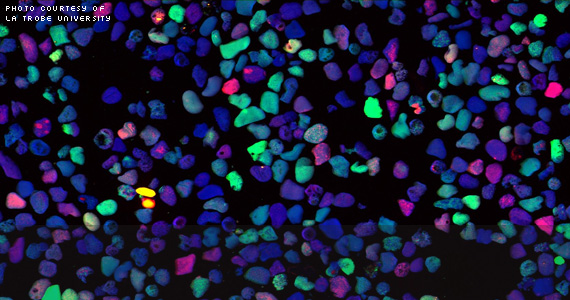 This synchrotron image shows the distribution of titanium (blue), niobium (green) and thorium (red) in ilmenite, an iron titanate ore.
This synchrotron image shows the distribution of titanium (blue), niobium (green) and thorium (red) in ilmenite, an iron titanate ore.
Ilmenite is an important industrial source of synthetic rutile, which is further processed to make titanium dioxide, commonly used as a pigment in paint and sunscreens.
Natural ilmenite typically contains small amounts of impurities such as manganese, aluminium and silicon. It can also contain traces of radioactive thorium, which must be removed along with the other impurities when ilmenite is processed to make synthetic rutile.
La Trobe University researcher Peter Kappen is using the Australian Synchrotron’s x-ray fluorescence microprobe beamline to examine the distribution of major and trace elements in ilmenite. Kappen and his colleagues also plan to use the synchrotron to investigate the detailed chemistry of these impurities. The work will ultimately help Australian industry to develop improved processes for producing high-quality synthetic rutile.
The x-ray fluorescence microprobe can resolve details as small as 0.1 micrometres across (less than one-thousandth the diameter of a typical human hair) and detect much lower concentrations of elements than laboratory-based techniques such as proton-induced x-ray emission (PIXE).
Acknowledgments
The ilmenite sample shown in the scan image above and on the home page was provided courtesy of Peter Kappen and La Trobe University.
The image was collected by the Australian Synchrotron XFM beamline team and CSIRO collaborators Chris Ryan, Robin Kirkham and Gareth Moorehead as part of testing and demonstrating the fast detector (Maia) capabilities of the x-ray fluorescence microprobe.
